55 Powerful Animal Testing Statistics
This page contains affiliate links. We may earn money or products from the companies mentioned in this post through our independently chosen links, which earn us a commission. Learn More
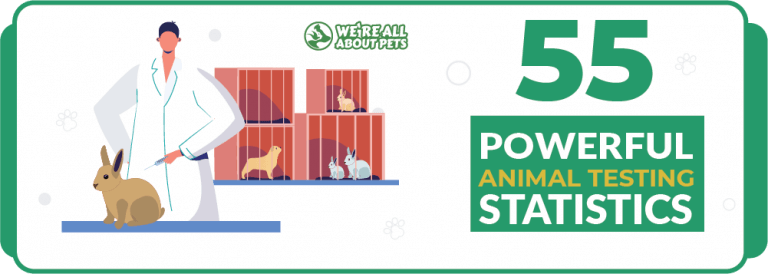
When you walk into your neighborhood pharmacy to grab a few essentials, you probably don’t think much about the process that put the products on the shelves. From formulation to development, consumer goods including pharmaceutical drugs, cosmetics, and other products go through extensive testing for safety and efficacy before they are approved for sale. Unfortunately, some of that testing involves animal subjects.
Check out our animal testing statistics infographic and keep reading to learn more!
10 Shocking Numbers About Animal Testing
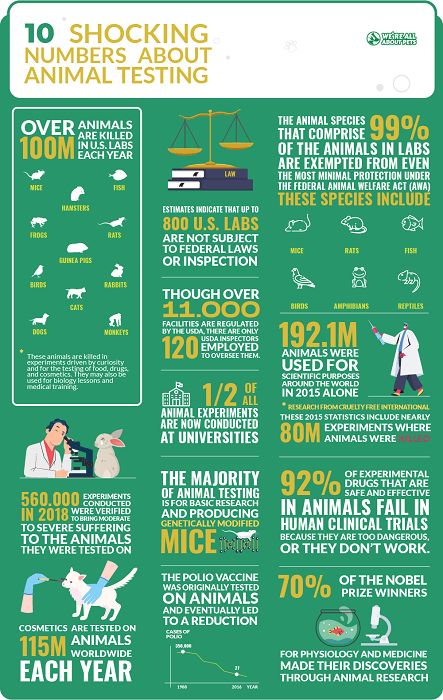
- Over 100 million animals are killed in U.S. labs each year. This includes mice, rats, frogs, dogs, cats, hamsters, rabbits, guinea pigs, monkeys, fish, and birds. These animals are killed in experiments driven by curiosity and for the testing of food, drugs, and cosmetics. They may also be used for biology lessons and medical training.
- The animal species that comprise 99% of the animals in labs are exempted from even the most minimal protection under the federal Animal Welfare Act (AWA). These species include mice, rats, birds, fish, reptiles, and amphibians.
- Estimates indicate that up to 800 U.S. labs are not subject to federal laws or inspection because they experiment exclusively on animals whose remains largely unregulated (like mice and rats).
- Though over 11,000 facilities are regulated by the USDA (including over 1,200 which have been designated for research), there are only 120 USDA inspectors employed to oversee them.
- Research from Cruelty Free International suggests at least 192.1 million animals were used for scientific purposes around the world in 2015 alone.
- These 2015 statistics include nearly 80 million experiments where animals were killed for their tissues or used to breed genetically modified animal strains.
- Half of all animal experiments are now conducted at universities. The majority of animal testing is not for drugs but for basic research and producing genetically modified mice.
- An estimated 92% (or higher) of experimental drugs that are safe and effective in animals fail in human clinical trials because they are too dangerous, or they don’t work.
- Nearly 560,000 experiments conducted in 2018 were verified to bring moderate to severe suffering to the animals they were tested on.
- Cosmetics are tested on 115 million animals worldwide each year. In some countries, rabbits and rodents don’t even count toward the final numbers.
- Approximately 70% of the Nobel Prize winners for physiology and medicine made their discoveries through animal research. The polio vaccine was originally tested on animals and eventually led to a reduction from 350,000 occurrences of polio in 1988 to just 27 cases in 2016.
Top 10 Animal Testing Statistics

The Top 10 Animal Testing Countries In The World Are:
- China (20.5 million)
- Japan (15 million)
- United States (15.6 million)
- Canada (3.6 million)
- Australia (3.2 million)
- South Korea (3.1 million)
- United Kingdom (2.6 million)
- Brazil (2.2 million)
- Germany (2 million)
- France (1.9 million)
The Top 10 Users Of Dogs In Animal Experiments Are:
- China
- United States
- Canada
- South Korea
- Japan
- Australia
- Brazil
- United Kingdom
- Germany
- India
The Top 10 Users Of Monkeys In Animal Experiments Are:
- United States
- China
- Japan
- Brazil
- Canada
- United Kingdom
- France
- Germany
- India
- South Korea
The Cost Of Animal Testing

- Animal testing is extremely expensive. The average length of time from discover to approval for a new drug is 14 years. During this process, the failure rate exceeds 95% and the cost for a successful drug can be over $1 billion.
- Publicly funded government agencies like the NIH are some of the largest sources of funding for animal experimentation. In 2019, the NIH budgeted nearly $40 billion for research and development.
- About 47% of NIH-funded research involves experimentation on non-human animals.
- Many charitable organizations – including the American Cancer Society and the March of Dimes – use donations to fund animal testing. About one-third of the projects funded by the National Multiple Sclerosis Society involve animal testing.
- Private companies, contract labs, and animal breeders are exempt from open-record laws that can be used to obtain information about animal testing from state institutions, government agencies, and federally funded facilities.
- Over $420 million has been invested in developing non-animal testing methods. For more than 40 years, Procter & Gamble has been invested and their main competitor, Unilever, has started pushing for a global ban on animal testing.
- The cost to register a single pesticide is estimated at $3 million. Many fail to pass the necessary requirements, wasting millions of dollars and destroying thousands of animals’ lives.
- In 2016, over $7.3 million in taxpayer money was spent on research involving animals. Furthermore, PETA revealed that over $56 million in government funding allocated for experimentation failed to yield useful results.
The Truth About Animal Testing
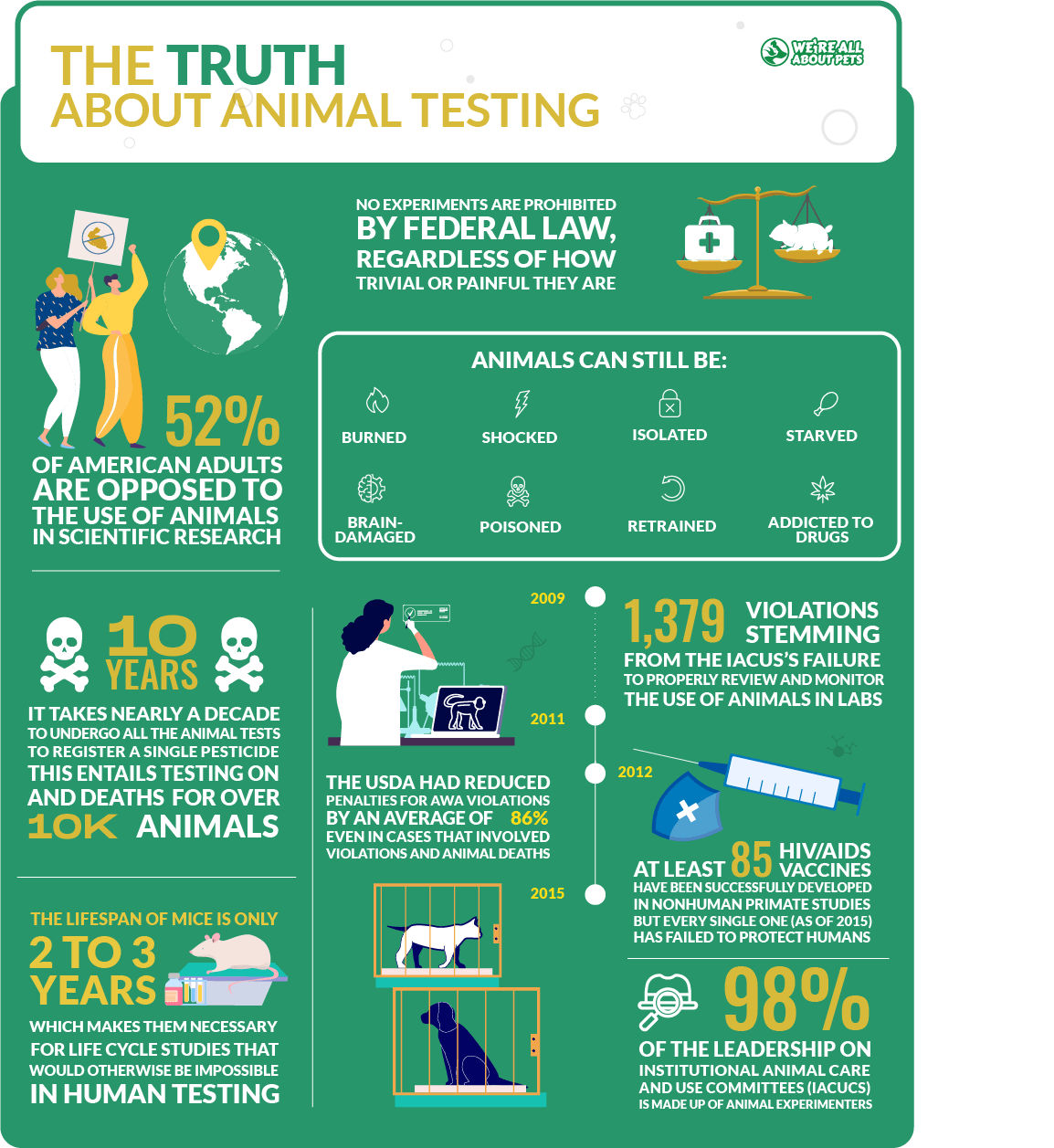
- A Pew Research Center poll found that 52% of American adults are opposed to the use of animals in scientific research. The ever-shrinking group that accepts animal testing believes animal experimentation is necessary for medical progress.
- The majority of animal experiments don’t contribute to improving human health. The value of the role animal experimentation plays in significant medical advances is questionable. According to an article published in The Journal of the American Medical Association (JAMA), medical treatments developed in animals rarely translate to humans.
- Diseases that are artificially induced in animals in a lab setting are never identical to those that occur naturally in humans. Because animal species differ in significant biological ways, the results of the experiment may not even be applicable to human medicine.
- At least 85 HIV/AIDS vaccines have been successfully developed in nonhuman primate studies but every single one (as of 2015) has failed to protect humans. In one case, the vaccine not only failed to protect humans from AIDS but may have made them more susceptible to developing it.
- Certain standards do exist, but oversight bodies called Institutional Animal Care and Use Committees (IACUCs) have repeatedly failed to enforce these standards. An audit highlighting citations from 2009 to 2011 alone revealed 1,379 violations stemming from the IACUS’s failure to properly review and monitor the use of animals in labs.
- In 2012, the same audit revealed that the USDA had reduced penalties for AWA violations by an average of 86%, even in cases that involved egregious violations and animal deaths.
- Research co-authored by PETA documented that over 98% of the leadership on Institutional Animal Care and Use Committees (IACUCs) is made up of animal experimenters
- In facilities that are fully compliant with the law, animals can still be burned, shocked, isolated, poisoned, starved, retrained, addicted to drugs, and brain-damaged. No experiments are prohibited by federal law, regardless of how trivial or painful they are.
- It takes nearly a decade to undergo all the animal tests to register a single pesticide. This entails testing on and deaths for over 10,000 animals.
- The lifespan of mice is only 2 to 3 years, which makes them necessary for life cycle studies that would otherwise be impossible in human testing.
European Animal Testing Statistics
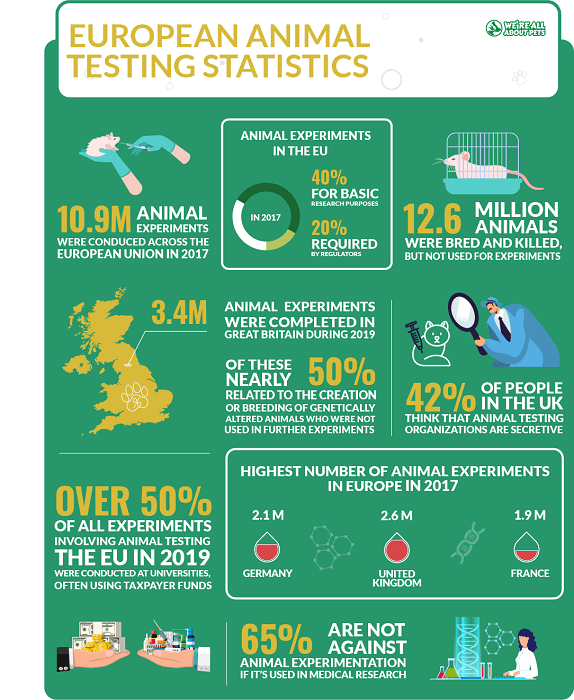
- An official report from the European Commission shows that 10.9 million animal experiments were conduced across the European Union in 2017. An additional 12.6 million animals were bred and killed, but not used for experiments.
- A total of 3.4 million animal experiments were completed in Great Britain during 2019. Of these, nearly 50% (1.67 million) related to the creation or breeding of genetically altered animals who were not used in further experiments.
- The United Kingdom now conducts the highest number of animal experiments in Europe (2.6 million in 2017). Germany is the second highest (2.1 million) with France third (1.9 million) in 2017.
- In 2017, 40% of animal experiments conducted in the European Union were for basic research purposes. Only 20% were required by regulators. Experiments are still being conducted in cases where there are valid non-animal alternatives available.
- Over 50% of all experiments involving animal testing the EU in 2019 were conducted at universities, often using taxpayer funds.
- Roughly 42% of people in the United Kingdom think that animal testing organizations are secretive. As many as 65% are not against animal experimentation if it’s used in medical research.
United States Animal Testing Statistics

- In the U.S. alone, as many as 100 million animals die from animal testing each year. This includes animals that die in dissection experiments, many in cases where advanced non-animal experimentation options are available.
- Over half of Americans (54%) feel animal testing for medical purposes is acceptable, regardless of the numerous alternatives available.
- About 43% of Americans feel testing on animals is morally wrong and an additional 2% feel it depends what the testing is for. Only 1% don’t have a specific opinion.
- In California alone in 2016, over 5,500 dogs and 2,200 cats were used for medical research.
- According to 2017 statistics, the most commonly used AWA-covered species in animal testing was the guinea pig with nearly 192,000 cases. The second most common animal was the rabbit, with 145,841.
- In the case of cosmetic testing involving animals, if the animal isn’t killed during the experiment they generally are when the experiment ends. In most cases, death is caused by decapitation, neck-breaking, or asphyxiation.
- The failure rate of animal testing experiments is over 90%. In the pharmaceutical industry, the failure rate is at least 96%.
Other Statistics On Animal Testing

- The EPA estimates a 30% reduction in the number of studies using animal testing by the hear 2025. The agency has also promised to invest over $4.2 million in developing alternatives to animal testing.
- Though many non-animal alternatives have been discovered and many animal tests are useless, statistics show that animal testing has not declined. In fact, the use of animals in scientific experimentation has increased in China.
- The majority of the primates (85%) used for experimentation in the EU in 2018 were imported from outside the region – largely from Africa and Southeast Asia.
- An estimated 80% of the primates used for animal experiments in the United States are imported from China. The new 15% levy on Chinese imports may affect this.
- Global 2018 statistics show that 75,000 animals are killed in testing each year by a single company – Huntingdon Life Sciences. Approximately 87% of the animals they kill are rodents.
- Only 3% of animals used for testing in Israel survive the lab experiments. Unfortunately, they are often killed or used for new trials when the research ends.
- Currently, about 40 countries around the world have banned cosmetics testing on animals. The EU Parliament is urging for a complete worldwide ban. France is the most prominent opponent.
- The United States passed a ban on cosmetics testing in 2015, but it still hasn’t been implemented.
- Many of the cosmetics tests used on animals have not been updated in decades. According to the Humane Society International, some of these tests were developed as long ago as the 1920s.
- As alternatives to animal testing become increasingly available, many companies are making a commitment to avoid animal testing. Over 1,000 companies worldwide have been certified as “cruelty-free.”






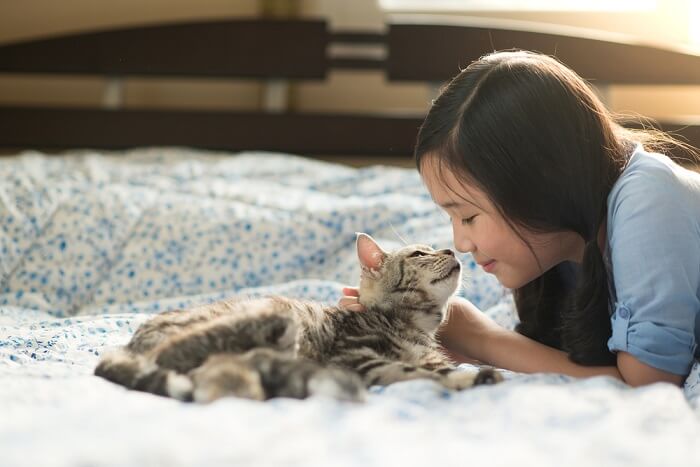

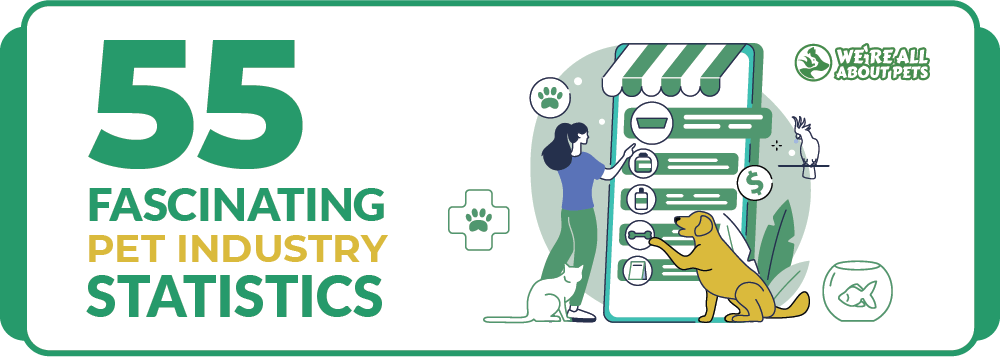
Anne
Very helpfull for a project that i needed to do on this topic
Kate Barrington
I'm glad to hear it, Anne!